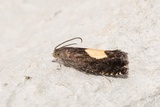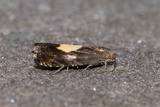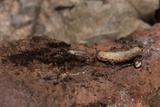Pammene regiana (Zeller, 1849) Species
Last modified: Nov. 25, 2025, 2:40 p.m.
A fairly common species throughout Belgium.
Details
- Classification
- Family: Tortricidae > Subfamily: Olethreutinae > Tribus: Grapholitini > Genus: Pammene > Species: Pammene regiana
- Vernacular names
- Maanmot (NL), Regal Piercer (EN), Tordeuse du Sycomore (FR), Bergahorn-Samenwickler (DE)
- First mention in Belgium
- De Crombrugghe G. 1898. Note sur quelques Lépidoptères nouveaux pour la faune belge. — Annales de la Société Entomologique de Belgique 42: 34–38. On page 35.
- Status
-
Native
Distribution
Imago
Wingspan 13–16 mm. A dark chocolate brown species, greyish basally and with a variable orange ochre shading towards the apex. There is a large clear medio-dorsal blotch of the forewing, orange-yellow and subfalcate, its outer edge curving to meet the dorsum well before the tornus.
Can be confused with Pammene trauniana, but this species is much blacker and has broader and shorter costal strigulae.
Caterpillar
Whitish larva with gray dots, head light brown, neck plate pale yellowish-white, lined with dark dots on the sides and back, anal valve brown.
Bionomics
The larva develops in the fruits on the host plant from August till September. The last instar larva moves to lower parts and descends on a silken thead. It spins a cocoon in a crevice or under bark scales that are not quite firmly attached to the trunk. The cocoons are almost always attached to the detached bark scale and not to the trunk underneath. It overwinteres there and doesn't pupate until next spring.
The adults usually fly around the treetops and later come to light.
Flight periods
The adults have been seen onwards from early April till late August, occasionally later.
Observed on
- Host plant (species):
- Acer pseudoplatanus
The larva feeds on Acer pseudoplatanus. Literature information on other maple species as Acer platanoides and A. campestre is questionable and in the case of the latter one probably incorrect.
Habitat
It inhabits woodland, parkland and solitary old sycamore maples trees.



